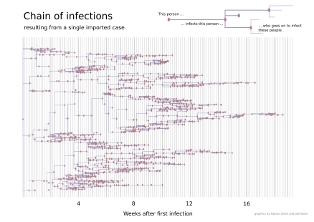Modelling Pandemic Influenza
One of the research group's projects is the computational modelling of the spread of infectious respiratory diseases such as influenza. Of particular interest are strains of "pandemic" influenza such as the "Swine flu" strain of A(H1N1) influenza that originated in Mexico in 2009. Highly infectious in nature, these strains have the potential to infect a large proportion of the world population. This research programme utilises extant mathematical modelling which has had extensive application to the dynamics of other complex systems and brings together researchers with skills in epidemiology, virology, modelling and software development. We have constructed a model to capture the dynamics of pandemic influenza in an Australian urban context with population mobility patterns extracted from ABS and other data sets. The simulation model has been used experimentally, each experiment being a separate simulation run, dealing with a particular scenario which "plays out" as time passes.

An infection
tree showing the simulated effects of a single infected individual
Modelling Alternative Control Strategies for Pandemic Influenza
The software system developed by the research group has been successfully used to analyse the effectiveness of a range of public health interventions including school closures, workforce reductions, community contact reductions, anti-viral drugs for treatment and prophylaxis, and vaccination. We have specifically applied the simulation model to determine optimal use of limited resources such as targeting of antiviral drugs and initial supplies of vaccine. These analyses have been documented in a series of journal publications.
Current Project: Study to determine the cost effective strategies and budget impact of the use of Quadrivalent vs Trivalent Influenza Vaccines in South Africa and Vietnam.
Funded by the World Health OrganisationCompleted Project: Modelling to determine the cost effective strategies to mitigate future influenza pandemics
Research into the cost effectiveness of pandemic influenza mitigation strategies was the subject of an NHMRC Project Grant .Related Publications
- Milne, G.J., Halder, N., M., Kelso, J., Barr. I.G., Moyes, J., Kahn, K., Twine, R., Cohen, C. (2016), Comparing trivalent and quadrivalent influenza vaccination effectiveness in three global settings. Influenza and Other Respiratory Viruses
- Milne GJ, 2015 Modelling diesase spread: Why do we need models? Presentation at Infectious Diseases Seminar, Telethon Kids Institute, Wesfarmers Centre of Vaccines and Infectious Diseases, May 2015
- Halder N,Kelso JK, Milne GJ, 2014 A model-based economic analysis of pre-pandemic influenza vaccination cost-effectiveness.BMC Infectious Diseases 14(1): 266
- Carrasco LR,
Jit M, Chen MI, Lee VL, Milne GJ,and Cook AR, 2013
Trends in parameterization,
economics and host behaviour in influenza pandemic modelling: a review and
reporting protocol. Emerging Themes in Epidemiology 10(3)
- Kelso JK,
Halder N, Milne GJ, 2013
Vaccination
strategies for future influenza pandemics; a severity-based cost effective
analysis. BMC Infectious Diseases 13(81): vdoi:10.1186/1471-2334-13-81
- Kelso JK, Halder N, Postma MJ, Milne GJ, 2013 Economic analysis of pandemic influenza mitigation strategies for five pandemic severity categories. BMC Public Health 13:211
- Milne GJ, Halder N, Kelso JK, 2013 The cost effectiveness of pandemic influenza interventions: A pandemic severity based analysis.PLoS ONE 8(4):e61504.doi:10.1371/journal.pone.0061504
- Milne GJ,
Baskaran, Halder N, Karl S, Kelso JK, 2013
Pandemic influenza
in Papua New Guinea: a modelling study comparison with pandemic spread in a
developed country. BMJ Open 3:e002518. doi:10.1136/bmjopen-2012-002518
- Milne GJ,
Kelso, Halder N, 2012
Lower NI efficacy may
significantly reduce pandemic intervention effectiveness [letter/rapid
response]. BMJ2012;345:e7304 rr/616540
- Halder N, Kelso
JK, Milne GJ, 2011
Cost-Effective
Strategies for Mitigating a Future Influenza Pandemic with H1N1 2009
Characteristics. PLoS ONE
6(7):e22087.doi:10.1371/journal.pone.0022087
- Kelso JK, Milne
GJ, 2011
Stochastic individual-based
modelling of influenza spread for the assessment of public health
interventions. MODSIM2011, 19th International Congress on
Modelling and Simulation. Modelling and Simulation Society of Australia
and New Zealand, Australia, 1, pp 933-939
- Halder N, Kelso
JK, Milne GJ, 2010
Developing
guidelines for school closure interventions to be used during a future
influenza pandemic. BMC Infectious Diseases 2010, 10:221 doi:10.1186/1471-2334-10-221
- Halder N, Kelso
JK, Milne GJ, 2010
Analysis
of the effectiveness of interventions used during the 2009 A/H1N1 influenza
pandemic. BMC Public Health 2010, 10:168 doi:10.1186/1471-2458-10-168
- Kelso JK,
Halder N, Milne GJ, 2010
The
Impact of Case Diagnosis Coverage and Diagnosis Delays on the Effectiveness of
Antiviral Strategies in Mitigating Pandemic Influenza A/H1N1 2009.
PLoS ONE 5(11):e13797.doi:10.1371/journal.pone.0013797
- Postma MJ, Milne G, Nelson EA, Pyenson B,Basili M, Coker R, Oxford J, Garrison LP Jr. 2010 Pharmaceutical interventions for mitigating an influenza pandemic: modeling the risks and health-economic impacts Expert Rev Anti Infect Ther. 8(12):1431-9.
- Milne GJ, Kelso JK, Kelly HA. 2009 Strategies for mitigating an influenza pandemic with pre-pandemic H5N1 vaccines. doi:10.1098/rsif.2009.0312 J. R. Soc. Interface 6 April 2010 vol. 7 no. 45 573-586>
-
Kelso JK, Milne GJ, Kelly HA. 2009
Simulation suggests that rapid activation of social
distancing can arrest epidemic development due to a novel strain of influenza.
BMC Public Health 2009, 9:117 doi:10.1186/1471-2458-9-117
-
Milne GJ, Kelso
JK, Kelly HA, Huband ST, McVernon
J, 2008.
A Small Community Model for the Transmission of Infectious
Diseases: Comparison of School Closure as an Intervention in Individual-Based
Models of an Influenza Pandemic. PLoS
ONE 3(12):e4005.doi:10.1371/journal.pone.0004005
-
Milne GJ, Kelso
JK, Kelly HA 2008
Quantifying the Effect of Vaccination and Non-Pharmaceutical
Interventions during an Influenza Pandemic via a Simulation Model
Report to the World Health Organisation
- Milne GJ, Kelso JK 2007 Quantifying the effect of non-pharmaceutical interventions during an influenza pandemic Report to the Commonwealth Department
